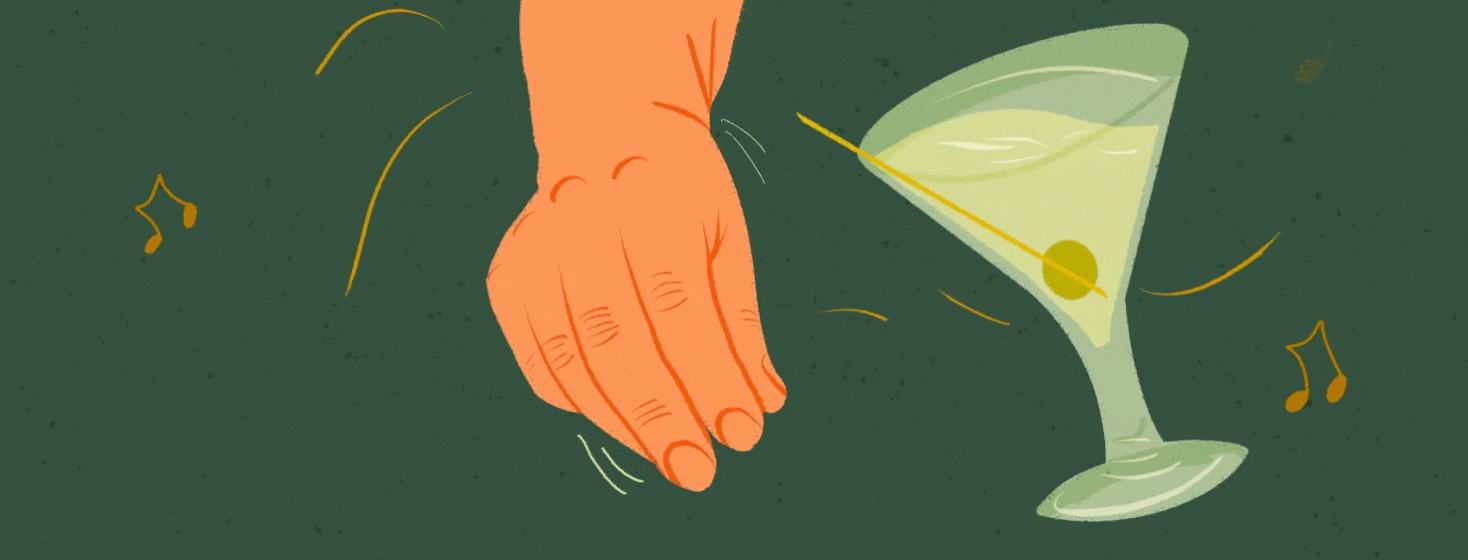Dealing with Tremors: Using Meds, Moves, & Humor to Cope
My guess is that most of you reading this know how fictional character James Bond likes his martini prepared. The phrase, “shaken, not stirred,” is as familiar as the way he introduces himself, “Bond, James Bond.” (If not, I suggest you watch a few old Bond movies.) I would also venture to guess that you are familiar with the musical phrase “shake, rattle, and roll.”
What do martinis and music have to do with Parkinson’s?
Tremor: A common Parkinson's symptom
Tremor is the most recognized external sign of Parkinson’s. A tremor is characterized by movements that are rhythmical and may occur during movement (action) or at rest. When tremor is a solitary symptom and occurs during action, it is typically recognized as an essential tremor.
Tremor at rest is one of the motor symptoms of Parkinson’s. Up to 70-80 percent of persons with Parkinson’s (PwP) have tremors, and I am one of them.
How can you tell the difference between an action tremor or one at rest? Handwriting provides an interesting comparison. Persons with essential tremor will produce very shaky looking handwriting. You might even describe their handwritten note as looking nervous, like they wrote it while riding a rapidly jerking roller coaster.
Persons with tremor due to Parkinson’s may have perfectly fine handwriting. Although their hands shake while resting in their lap, they stop shaking during purposeful movement such as writing. An interesting side note about handwriting and Parkinson’s is micrographia. PwP may develop progressively smaller handwriting that is difficult to read regardless of having tremor.
Shake, rattle, & roll: How I describe my tremors, posture, & gait
Tremor and other extraneous involuntary movements give new meaning to the idiom, “marching to the beat of your own drum.” PwP may say they shake, rattle, and roll when describing their personal tremors, posture, and gait. I know I did when trying to explain what my body was doing when I was first diagnosed.
My left hand seemed to be into song leading while my left foot felt more like a heavy drumbeat. My stride seemed to roll a little off balance and to the left. Postural instability and dyskinesia may make you look like you are walking (poorly) on a rolling boat deck. I have heard some folks with Parkinson’s say that instead of marching, they dance to their own music.
“Optimist: someone who figures that taking a step backward
after taking a step forward is not a disaster, it’s more like a cha-cha.” Robert Brault
Meds, moves, & humor: Ways to help cope with my Parkinson's
Parkinson’s medications are intended to be helpful, but in some cases may seem like a two-edged sword. The medicine alleviates symptoms but may also cause other symptoms over time or have undesirable side effects. For example, when you take carbidopa-levodopa for years, you may develop dyskinesias, which are random writhing or jerking motions.
Exercise, in general, and dance, in particular, are good for individuals with Parkinson’s. Many types of exercise help with stride, balance, and strength.
Some PwP are advocates of boxing and Tai Chi. Others prefer resistance training, cycling, and cadence walking. There are PwP who prefer group classes like Zumba or yoga.
Exercise may not have the same effect on tremor as medication, but it is helpful in its own way. Consult a personal trainer with a history of working with PwP or attend classes geared toward your Parkinson’s stage. Your hand may shake, but if it is strong then you can better perform activities of daily living like opening bottles or holding your grandchild’s hand during a walk in the park.
Stirred to positivity: Why a positive attitude is important with Parkinson's
Yes, there may be days we PwP feel rattled; unsettled by our PD. There may be episodes of tremor or pill rolling that we did not instigate and do not want. Medications, exercise, and positive mental health behaviors help reduce symptoms and provide coping mechanisms.
A positive attitude and humor have helped Beverly Ribaudo. She writes in her blog about the role of humor before and after her diagnosis at 47 with young adult-onset Parkinson’s. “Laughter is the best medicine” guides the creators of an improvisation program for PwP.
Neither of these specifically target tremors, but you can surely find some laughable moments about unexpected body movements. The attitude we choose each day sincerely helps frame our outlook, so why not be as optimistic as possible?
Has Parkinson’s changed your life? Will it continue to do so? Does this shake you into an uncomfortable state of mind? We learn more about our personal Parkinson’s experience over time, but I refuse to think of my body as one of Bond’s martinis or a rock and roll song. Instead, I consider myself as uniquely stirred, but not shaken. Join me?
“Nothing is impossible, the word itself says “I’m possible!” Audrey Hepburn
Do you use movement and humor to help manage your Parkinson's symptoms? Share in the comments below.

Join the conversation